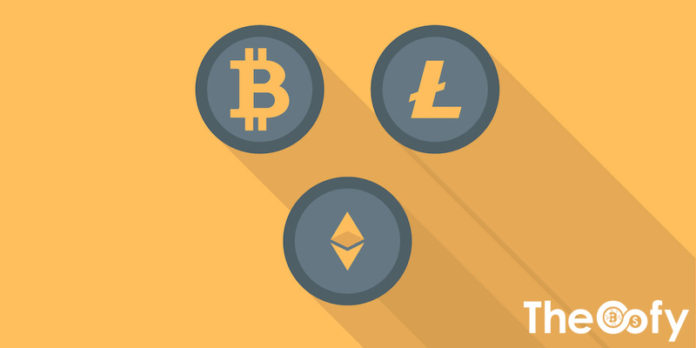
Could Litecoin reach the same high as Bitcoin? Michael LaVered of cryptocurrency news site Oracle Times says Litecoin could potentially overtake in bitcoin in price as the latter “is having difficulty scaling to the level needed for general commerce” with high fees and longer transaction times. He wrote today: “The litecoin could be the solution. Litecoin combines all of the benefits of Bitcoin, but with shorter transaction times and lower fees. “It has been on the forefront of bitcoin innovations, implementing SegWit [soft fork change in Bitcoin] early last year and now offering the possibility of lightning network and atomic swaps.”
Table of Contents
Speed
Transaction confirmation speeds play a huge role in how quickly a currency gets adopted. Bitcoin confirmations usually take around ten minutes with periods as high as 2,548 minutes. Litecoin’s network is able to confirm transactions at a much quicker rate.
Litecoin’s verification period lasts a fixed 2.5 minutes. For every individual Bitcoin block that gets confirmed, four Litecoin blocks of equal size get confirmed.
Cost
The cost of sending any denomination of LTC costs around $0.02, whereas Bitcoin currently hovers around $0.35. The costs are all but negligible currently, however, during peak traffic, Bitcoin transaction costs appear to rise quite dramatically. This is an immediate advantage for small transactions since splitting a $10 Uber with a friend doesn’t make sense for most people if you have to pay $5.00 on top of that. Litecoin offers the option to pay for everyday goods without high fees that start to add up very quickly.
Mining
One of Litecoin’s goals is to distribute hash power more evenly than Bitcoin’s network. This includes mining pools, mining groups, and a much smaller (and less decentralized) subset of miners. Litecoin aims to keep the hashing power decentralized.
Litecoin’s mining also keeps transaction fees relatively low due to the inherently higher total supply. There can only be 21 million Bitcoins in existence, whereas there can be up to 84 million Litecoins. This matters because it makes mining less competitive, and the more competitive mining gets, the higher the transaction fees.
While Bitcoin is dealing with some serious scalability issues due to its high transaction fees, Litecoin, in theory, is able to churn out block after block and retain its lower transaction costs. Granted, not as many people are using Litecoin as they are Bitcoin and could theoretically end up dealing with the same scalability issues if it were to experience similar growth and usage, but that simply just isn’t the case yet.
Litecoin also uses the Scrypt hashing algorithm that utilizes much less processing power than the Bitcoin SHA-256 hashing algorithm. Placing a higher emphasis on utilizing high-speed RAM, Litecoin makes it much less possible for a single player (or small collective group of big players) to dominate the mining world.
Litecoin is proving to be a cheap cross border alternative
Even though Litecoin (LTC)–like all coins may be recovering, the decision made by the Litecoin Foundation that they will be complementing Bitcoin (as its silver) was strategic and is now paying dividends. Trading at around one percent of Bitcoin’s value, Litecoin is proving to be a cheap cross border alternative that governments like Venezuela are recognizing. Besides, it is available in almost all exchanges across the world meaning it is liquid and suitable for merchants.
Aside from being a medium of exchange—and gravitating towards privacy, Litecoin (LTC) and Bitcoin will be the two coins that users can use as agents of remittance. The Venezuelan backed crypto platform, Remesas only accept Bitcoin and Litecoin.
It will run on the Patria under the direct oversight of Superintendency of Cryptoassets and Related Activities (SUNACRIP), the country’s regulator.
“Remesas is a service of the Patria Platform that allows you to send remittances to Venezuela in Cryptocurrencies. The resources sent will be available in Sovereign Bolivars in the Monedero Patria as soon as the transfer is confirmed. The cryptocurrencies that can be used to send [remittances] are Bitcoin and Litecoin.”
Pros of Litecoin
- Litecoin is an open source project, which means that it has the capability and flexibility to implement relevant and useful tech improvements, such as SegWit and the lightning network. In that matter, it is an improved Bitcoin version, which is logical since it was a fork of it.
- It is considerably faster than Bitcoin, completing transactions in an average of 2.5 minutes, compared to the 10 minutes it takes to perform a similar operation in the latter.
- It represents a cheaper option for people looking to perform transactions, with an almost zero transaction fee compared to Bitcoin.
- The process of mining can be more straightforward on Litecoin than in Bitcoin (although that concept is debatable,) since it uses the new Proof of Work algorithm.
- It was created by a former Google employee, which brings a sense of reliability and trustworthiness to the equation.
- It has a less “toxic” community since it doesn’t quite have the reach of Bitcoin.
- It is considerably less volatile during market crashes or corrections than some of its peers.
- The developers and founders have shown excellent leadership skills throughout time: Charlie Lee left Coinbase as the head of engineering with the intention of focusing full-time on the Litecoin project.
- There are atomic swaps between LTC/BTC.
- The presence of the Lightning Network, a platform that fosters and promotes faster transactions.
- The 84M total supply.
- The market cap is very low if you compare Litecoin to other tokens at the top of the market.
- Chinese people are fond of it, which is an excellent marketing development since it represents the most significant pool of potential users.
- All hardware wallets support Litecoin.
Cons of Litecoin
- People are still waiting for a counter-move now that Bitcoin added SegWit to its catalog of offerings. With that development, Litecoin lost one of the values that made it different.
- Since Litecoin is a fork of Bitcoin, or a new version of you prefer the term, it implies that there will be few, if any, new and innovative ideas, which is something that altcoins have to offer.
- Litecoin market will be somewhat damaged until Bitcoin’s scaling problem is solved.
- The people’s perception may hurt the name of Litecoin. Numerous people seem to think that it is the same as Bitcoin. It may be some time if it happens at all before Litecoin reaches the prominence and sustainability that Bitcoin showcases every year.
Potential in Litecoin:
Also, there have been a lot of different developments in Litecoin. There was also a fork in Litecoin which led to Litecoin cash. Also, Litecoin uses the different algorithm as compared to Bitcoin. This increases the transaction speeds of Litecoin. Moreover, the block of Litecoin is created within 2.5 minutes. This ensures that it is much faster as compared to Bitcoin. This is one of the main reasons why it is gaining more and more traction as well. Also, it is much cheaper than Bitcoin numerically. This is the reason why traders are also using it on a consistent basis. Owing to this very reason, many traders think that it can increase significantly in the future.
Will Litecoin be able to overtake Bitcoin?
Moreover, one advantage which Bitcoin has and will always have over Litecoin is that it is the pioneer in the cryptocurrency space. Owing to this very reason, it will be very difficult for Litecoin to overtake Bitcoin. This is the reason why even though it might provide you with the appreciation in the future but it is difficult for Litecoin to increase further. It has already fallen significantly from the peak. This is making investors nervous as well. Many of the investors are stuck at the peak levels. This is the reason why even after the recent developments, most of the people are not entirely bullish on Litecoin. Many traders think that most of the appreciation which was about to come in Litecoin has already past. This is the reason why from current levels, it is not slated to rise further. Thus, while Litecoin can provide you with decent returns but it might never overtake Bitcoin.
Litecoin Predictions: A solidly built network that oozes potential in 2019
Although some altcoins are earning prestige and global relevance with each passing day, Bitcoin is still hands down the most prominent cryptocurrency in a market with increasing appreciation of the benefits that cryptography and the blockchain technology can provide transactions. However, that doesn’t mean that there isn’t space for altcoins to grow, and solidify their spots as successful ventures and companies. Among them, Litecoin seems to be the preferred option for savvy investors in the crypto universe. For reference, altcoins are all the distinct cryptocurrencies from Bitcoin, the industry’s leader since 2009, and Litecoin may the best, most secure, and the one with the most untapped potential. Abbreviated LTC, or Ł, Litecoin can be defined as a peer-to-peer cryptocurrency and open source software project. It functions under the MIT/X11 license, and Charlie Lee created and developed it. As is the case with Bitcoin and most altcoins, Litecoin is a decentralized entity, which means that it functions without a central authority or governance agency. The system allows the creation and transfer of tokens, based on an open source cryptographic protocol. The latest release of Litecoin is the 0.15.1 version, from March 2018. C++ is the code language, and the compatible Operating Systems are Windows, OS X, Linux, Android. The Litecoin Core Development Team is the one in charge of the development. As far as the ledger information, the timestamping scheme is Proof-of-work, and the hash function works around with scrypt. There is a block reward of 25 LTC, approximately until 2019, halved roughly every four years. The average block time is 2.5 minutes.
Bitcoin vs Litecoin
Differences from Bitcoin
Pundits always say that, by being a fork of Bitcoin, the two cryptocurrencies share numerous similarities, and the statement may be true to some extent. Both of them share the same codebase, are deflationary and use proof of work mining, for example. However, the differences between them are more than palpable. For starters, it is evident that Litecoin’s transaction times are way faster than those of Bitcoin, which usually take an average of 10 minutes to complete an operation. Litecoin stops the clock at 2.5 seconds, and as you saw in the previous section, the number can be significantly less. Ethereum, another one of the top crypto networks on the planet, also struggles with network and speed problems. Litecoin’s usability is what puts it ahead of other altcoins and competing with Bitcoin for the market share. People use it for standard blockchain-related procedures, such as lifting a smart contract, but it also has the capability, technologically speaking, of being used as currency, in the way of fiat money. Litecoin, also to provide the best environment for quick and secure transactions, also offers a cheap option. The currently reviewed system implements scrypt in its proof-of-work algorithm, which is mostly a sequential memory-hard function that needs more memory than a not memory-hard algorithm. The use of the previously described method makes Litecoin mining harder than Bitcoin’s, which is a negative point in the comparison, but a difference nonetheless.






























